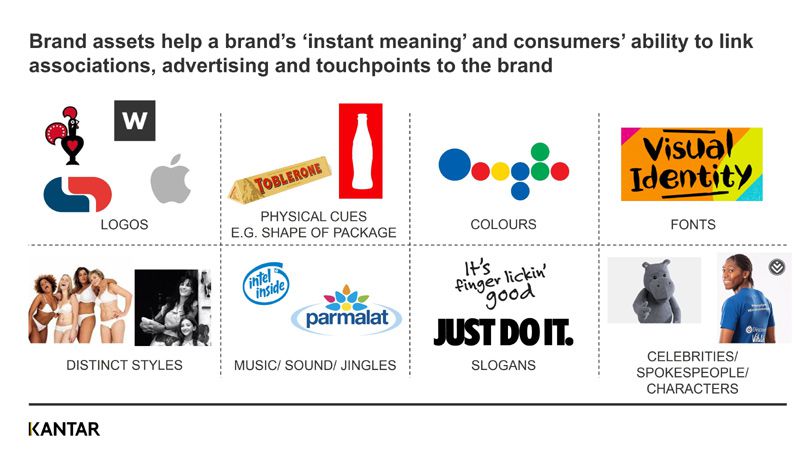Ultimately, predisposed consumers end up buying with less reminding, because you have succeeded in building up a bank of cumulative associations on which they have come to rely. As a result, they don’t need to evaluate their options every time they make a decision because they have already created a mental shortcut. Of course, this predisposition isn’t open-ended or infinite; rather, you need to keep reinforcing it through marketing and brand experience.
BrandingMary Kyriakidi, Kantar 26 Aug 2021
How do you then capitalise on this predisposition and enable people to pick your brands quickly and easily? You need to trigger instant recognition that taps into the shortcut you’ve created. Enter brand assets. According to Romaniuk and Sharp in How Brands Grow, brand assets, or distinctive assets, are defined as "non-brand name elements, such as colours, logos, characters and fonts that can trigger the brand for category buyers". To this list we can add packaging, slogans, advertising style, celebrities, and audio in the form of jingles, music, and ringtones.
Global brands that have succeeded in creating instantly recognisable assets include Coca-Cola with its dynamic ribbon device and unique bottle shape, McDonald’s with its golden arches and Ronald McDonald clown, and Intel with its distinctive sound. Closer to home, Allan Gray introduced a unique visual creative style with their sepia TV ads. Unfortunately, it was copied by their competitors and for a few years became a generic cue for financial services. Capitec Bank has created the Capitec Bank sound, while older South Africans can probably still sing along to "Have a ding dong day, DairyBelle", despite the brand being long gone. Savanna Cider used comedian Barry Hilton as the face of the brand from 1999 to 2011, and Katlego Maboe became so synonymous with OUTsurance that there was a petition to reinstate him as spokesperson after a personal scandal saw him replaced.

Where do these brand assets matter most? Having laid down shortcuts, marketers need to ensure their mental and physical availability to consumers – and avoid having them review their choices if the brand is not obvious when they come looking for it. For improved mental availability, brand assets give you an opportunity to increase your branding in your advertising. By consistently integrating assets into all of your communications at various touchpoints, you can reinforce mental connections to your associations. From a physical availability perspective, consumers are overwhelmed by choice in a competitive and cluttered shopping and search environment, both online and offline. Brands need a way to stand out and achieve instant recognition.
You can only truly optimise your brand assets by knowing each asset’s strength and where it can have the most impact. Kantar measures brand assets with three key metrics:
- Fame. The percentage of people who correctly associate an asset with a brand.
- Distinctiveness. The extent to which people associate the asset with just one brand, rather than misattributing it to a competitor.
- Intuitiveness. The extent to which the asset is instinctively associated with the brand or is one that requires considered thought.
The most effective brand assets are those that are instantly associated with the brand, rather than those that require more reflection.
Understanding how your assets perform on these measures can assist with effective touchpoint management by showing you which assets can help increase your prominence in store or online, which can best be leveraged in your communications, and whether some of them are better suited to particular media channels than others. For example, famous, intuitive, and distinctive assets would be suitable for use in all media, while assets that are well known and distinctive but not yet intuitive are better for channels where consumers have more time to process them and where they typically spend more time on content, such as print, magazines, and more engaging digital environments, such as social media.
BrandingDuncan Southgate, Kantar 7 Sep 2021
Mary Kyriakidi of Kantar points out in her article, 'What Is Brand Equity?’, that an instantly recognisable brand is not always the chosen one. You need to remember that it all starts with predisposition. After all, it is much easier to reinforce an existing association by reminding consumers of what they already know than it is to start building a new one. Uncover assets with the potential to build your brand and increase its mental availability. Brand Imprint measures how well each asset cues the brand at key decision points.
Follow us on LinkedIn and Twitter for our latest insights to help you understand people and inspire growth.
